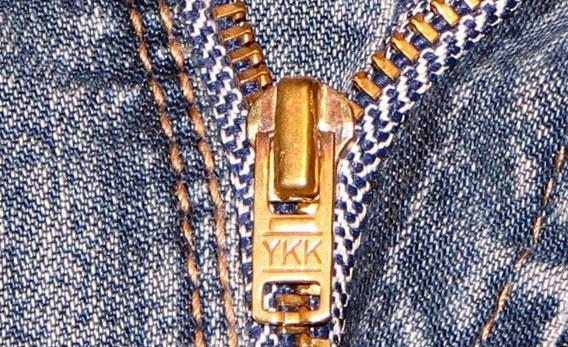The zipper is one of those inventions—along with the bicycle—that seems as though it should have occurred much earlier in history. How complicated could it be to assemble two wheels, two pedals, and a chain? Or to align two jagged strips of metal teeth and shuffle them together? There is no complicated chemistry here, no harnessing of invisible wavelengths. And yet the modern bicycle didn’t appear until the late 1800s, and the zipper didn’t really become the zipper until 1917 (when it was patented by a Swedish immigrant in Hoboken). The precision necessary to craft a working bicycle chain or a smoothly meshing zipper was simply beyond us for all those prior millennia.
More confounding still: Now that the zipper has been around for nearly a century, you’d think that something so simple might have been perfected—becoming a 100 percent reliable commodity. But that hasn’t happened. There are still tons of faulty zippers out there. Teeth that break. Pulls that pop. Herky-jerky sliding and irreparable lockups.
One zipper gone wrong can render an entire garment unwearable. Thus consistent quality is a must for reputable fashion brands. For decades now, apparel makers who can’t afford to gamble on cut-rate fasteners have overwhelmingly turned to a single manufacturer. YKK, the Japanese zipper behemoth, makes roughly half of all the zippers on earth. More than 7 billion zippers each year. Those three capital letters are ubiquitous—no doubt you’ve seen them while zipping up your windbreaker or unzipping someone else’s jeans. How did YKK come to dominate this quirky corner of industry?
Founded by Tadao Yoshida in Tokyo in 1934, YKK stands for Yoshida Kogyo Kabushikikaisha (which roughly translates as Yoshida Company Limited). The young Yoshida was a tinkerer who designed his own customized zipper machines when he wasn’t satisfied with existing production methods. One by one, Yoshida brought basically every stage of the zipper making process in house: A 1998 Los Angeles Times story reported that YKK “smelts its own brass, concocts its own polyester, spins and twists its own thread, weaves and color-dyes cloth for its zipper tapes, forges and molds its scooped zipper teeth …” and on and on. YKK even makes the boxes it ships its zippers in. And of course it still manufactures its own zipper-manufacturing machines—which it carefully hides from the eyes of competitors. With every tiny detail handled under YKK’s roof, outside variables get eliminated and the company can assure consistent quality and speed of production. (When the Japanese earthquake hit last year many supply chains were shredded, but YKK kept rolling along.)
Yoshida also preached a management principle he termed “The Cycle of Goodness.” It holds that “no one prospers unless he renders benefit to others.” In practice, this boiled down to Yoshida striving to produce ever-higher quality with ever-lower costs. It seems intuitive, but it’s far from easy to do. And in the end, the secret to YKK’s success is equally uncomplicated but equally impressive: YKK makes incredibly dependable zippers, ships them on time without fail, offers a wide range of colors, materials, and styles, and never gets badly undercut on price. The feeling in the apparel industry is that you can’t go wrong with YKK.
“There have been quality problems in the past when we’ve used cheaper zippers,” says Trina Turk, who designs her own line of women’s contemporary sportswear. “Now we just stick with YKK. When the customer is buying $200 pants, they better have a good zipper. Because the customer will blame the maker of the whole garment even if the zipper was the part that failed.”
A typical 14-inch “invisible” YKK nylon zipper (the kind that disappears behind fabric when you zip up the back of a dress) costs about 32 cents. For an apparel maker designing a garment that will cost $40-$65 to manufacture, and will retail for three times that much or more, it’s simply not worth it to skimp. “The last thing we want to do is go with a competitor to save eight or nine cents per zipper and then have those zippers pop,” says Steve Clima, Turk’s senior production manager. “The cost difference just isn’t enough given the overall margins.”
There are hundreds of rival zipper manufacturers in China. They might be a tiny bit cheaper, or might be willing to produce custom novelty orders in a rush. But at least one apparel wholesaler told me that some European companies won’t even accept delivery of garments using Chinese zippers, for fear that the zippers might contain lead (a big no-no). More generally, competitors’ zippers are often just not up to snuff. Multiple apparel designers I talked to recalled incidents in which batches of non-YKK zippers failed to meet their standards.
YKK isn’t the kind of brand that markets to consumers. (Or seeks any kind of publicity: They declined to speak to me for this story.) You don’t buy your jeans and jackets by looking for their letters on that pull. Likewise, you almost certainly wouldn’t nix a garment purchase because the zipper isn’t YKK.
But YKK is still a brand of sorts. It still has an image and a reputation. Its target demographic is trim buyers and production managers in the apparel industry. They’re the folks for whom “YKK” has real meaning.
There used to be a saying among corporate technology workers—or, as you might call them, I.T. guys—which held that “you’ll never get fired for using Microsoft.” Sure, you could take a risk on some upstart competitor and maybe save a little dough, or even get slightly better performance. But if anything goes wrong your boss will wonder why you didn’t opt for old reliable.
YKK, for decades now, has established itself as old reliable. “A zipper will never make a garment,” says Turk. “But it can break a garment.”
